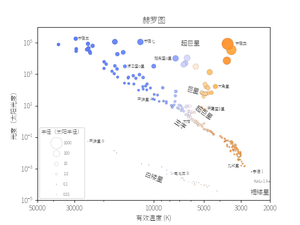Glossary term: 光度等级
Description: 恒星的内在亮度取决于其温度和物理大小。温度越高、体积越大的恒星越亮。光谱类型是根据恒星光谱的特征进行分类。这大致反映了温度的变化。光度等级则是根据恒星与同光谱类型的其他恒星相比的亮度来分类。光度等级用罗马数字表示:主序上燃烧氢的恒星被划分为矮星(V)。例如,太阳的分类是 G2 V。在它们之上(随着大小和亮度增加)依次是亚巨星(IV)、巨星(III)、亮巨星(II)和超巨星(Ib代表亮度较低,Ia代表亮度最高)。所有这些类型的恒星都是演化了的恒星,其内核中的氢已经燃烧殆尽。贫金属亚矮星是金属含量较低的氢燃烧恒星,位于主序以下。最后,白矮星(恒星残骸)则位于主序更下方。
Related Terms:
See this term in other languages
Term and definition status: The original definition of this term in English have been approved by a research astronomer and a teacher The translation of this term and its definition is still awaiting approval
The OAE Multilingual Glossary is a project of the IAU Office of Astronomy for Education (OAE) in collaboration with the IAU Office of Astronomy Outreach (OAO). The terms and definitions were chosen, written and reviewed by a collective effort from the OAE, the OAE Centers and Nodes, the OAE National Astronomy Education Coordinators (NAECs) and other volunteers. You can find a full list of credits here. All glossary terms and their definitions are released under a Creative Commons CC BY-4.0 license and should be credited to "IAU OAE".
If you notice a factual or translation error in this glossary term or definition then please get in touch.
Related Diagrams
赫罗图
Credit: IAU OAE/Niall Deacon
License: CC-BY-4.0 Creative Commons 署名 4.0 国际 (CC BY 4.0) icons









